Volvo Penta (Garmin) Glass Cockpit, just the beginning?
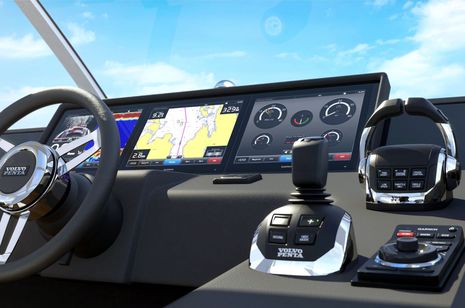 When I wrote about seeing the new Garmin 8000 Glass Helm series in Miami, several knowledgeable readers commented about how it (and the GMI 20 I’m testing) would be used as part of a complete Volvo Penta engine/helm package. They were right. Garmin announced the VP Glass Cockpit yesterday and it’s already up in detail at Volvo Penta. The main features seem to be great nav screen integration with joystick, trim, and autopilot controls plus a single vendor for all, but is this also what we’re going to see from all the glass bridge/helm/cockpit systems, and will it “trickle down”?
When I wrote about seeing the new Garmin 8000 Glass Helm series in Miami, several knowledgeable readers commented about how it (and the GMI 20 I’m testing) would be used as part of a complete Volvo Penta engine/helm package. They were right. Garmin announced the VP Glass Cockpit yesterday and it’s already up in detail at Volvo Penta. The main features seem to be great nav screen integration with joystick, trim, and autopilot controls plus a single vendor for all, but is this also what we’re going to see from all the glass bridge/helm/cockpit systems, and will it “trickle down”?
I don’t know the answer to that question. On the one hand Garmin announced a special relationship with VP two years ago. On the other hand, since then we’ve seen the emergence of Furuno NavNet TZTouch and Raymarine gS Series systems with similar high-end glass style and integration capabilities, and I’d bet a box of donuts that Simrad has something beyond NSO systems and monitors in the oven. Might Volvo create glass bridges with other electronics companies or Garmin with, say, Catapillar? Can all the engine and electronics manufacturers get to better compatability without it being a big deal?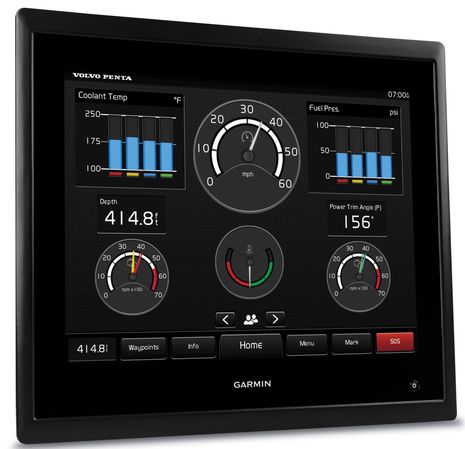 Afterall, one key to tight integration between your propulsion and nav systems is simply passing the monitoring data over NMEA 2000 to nav screens that can display it better than dedicated gauges. That’s been theoretically possible for about a decade, but remains quite rare for what seems like many possible reasons. The standard N2K messages may not support every engine and trim data field yet, few engine manufacturers have enabled N2K output — maybe because they wanted to sell their own screens or maybe because they feared problems, or some combination of both — and hence there hasn’t much reason for MFD developers to put much energy into their engine screens.
Afterall, one key to tight integration between your propulsion and nav systems is simply passing the monitoring data over NMEA 2000 to nav screens that can display it better than dedicated gauges. That’s been theoretically possible for about a decade, but remains quite rare for what seems like many possible reasons. The standard N2K messages may not support every engine and trim data field yet, few engine manufacturers have enabled N2K output — maybe because they wanted to sell their own screens or maybe because they feared problems, or some combination of both — and hence there hasn’t much reason for MFD developers to put much energy into their engine screens.
So Volvo Penta is using big, beautiful Garmin 8000 screens instead of their own guages — and you can see how informative and responsive they are in this excellent Randy Vance video — but will there be downside to this? Will the Glass Cockpit be even more expensive than the Glass Helm? Will Garmin updates and accessories get to Volvo Penta customers as quickly?
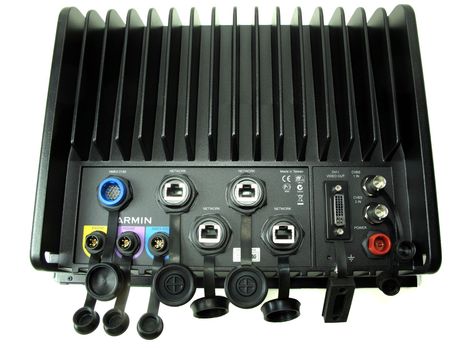 I was pondering these questions as I unpacked a Garmin 8212 in the lab yesterday, and was pleasantly surprised to find that the triple CANbus/N2K ports I spotted on the black box models are also on the MFDs. It seems very likely that the Volvo Penta engine and trim systems plug into that yellow Engine port and are thus separate from the boat’s regular navigation NMEA 2000 network. I’m not convinced that’s necessary — especially since the Garmin portion of the Glass Cockpit does not seem to actually control shift and throttle (also theoretically possible with N2K) — but I can picture how it’s more reliable to have just two developement teams working on a sub-network even if they’re using a multi-manufacturer standard. (And isn’t it fun to imagine what Garmin has in mind for that “House” port?)
I was pondering these questions as I unpacked a Garmin 8212 in the lab yesterday, and was pleasantly surprised to find that the triple CANbus/N2K ports I spotted on the black box models are also on the MFDs. It seems very likely that the Volvo Penta engine and trim systems plug into that yellow Engine port and are thus separate from the boat’s regular navigation NMEA 2000 network. I’m not convinced that’s necessary — especially since the Garmin portion of the Glass Cockpit does not seem to actually control shift and throttle (also theoretically possible with N2K) — but I can picture how it’s more reliable to have just two developement teams working on a sub-network even if they’re using a multi-manufacturer standard. (And isn’t it fun to imagine what Garmin has in mind for that “House” port?)
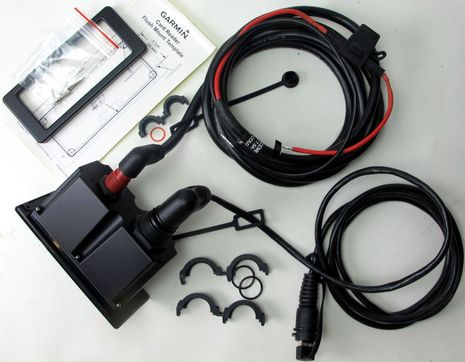 The 8000 series certainly seems built to heavy-duty engine-like standards. In fact, I was amazed to find that the separate card reader has a 7.5 amp power cable until I realized that they are simply using the same power cable for it, the 8212, and also the GRID keypad. Note the blade fuse, cable/plug color coding, right angle connectors and snap-on outer rings that I first spotted on the 7000 Series. When I visited binnacle and pod manufacturer Edson Marine in May, company president Will Keene told me that he wished electronics companies would make cables with a narrow connector on one end and a right angle connector on the other. Garmin seems close but I wonder if Raymarine’s new RayNet Ethernet cabling isn’t even easier to run with no extra parts to worry about.
The 8000 series certainly seems built to heavy-duty engine-like standards. In fact, I was amazed to find that the separate card reader has a 7.5 amp power cable until I realized that they are simply using the same power cable for it, the 8212, and also the GRID keypad. Note the blade fuse, cable/plug color coding, right angle connectors and snap-on outer rings that I first spotted on the 7000 Series. When I visited binnacle and pod manufacturer Edson Marine in May, company president Will Keene told me that he wished electronics companies would make cables with a narrow connector on one end and a right angle connector on the other. Garmin seems close but I wonder if Raymarine’s new RayNet Ethernet cabling isn’t even easier to run with no extra parts to worry about.
The way the Ray gS Series card reader gets power and data via a single waterproof USB cable — discussed here on Tuesday (it’s glass bridge week!) — also seems like an easier install, but then again I want to loadly applaud the working side of the 8000 reader seen below. Garmin is using full size SD cards, which means they can be clearly labeled and they are less likely to blow overboard than the micro variety. Plus a micro SD card can always be put in a full size SD slot, with an adaptor, but not vice versa. Garmin also numbered the card slots, which will be useful when a user makes decisions like which one to save routes and tracks to, and they even indicated the correct card orientation. Anyone else have an MFD that could use these nicities?
Excuse the sidetrack, but even the biggest systems are at least in part a conglomeration of details that can make your boating simpler, or not. Anyone excited about the Volvo Penta Glass Cockpit, and/or the prospect of such propulsion control integration coming to other and maybe smaller screens?


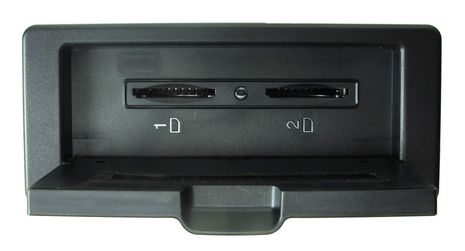



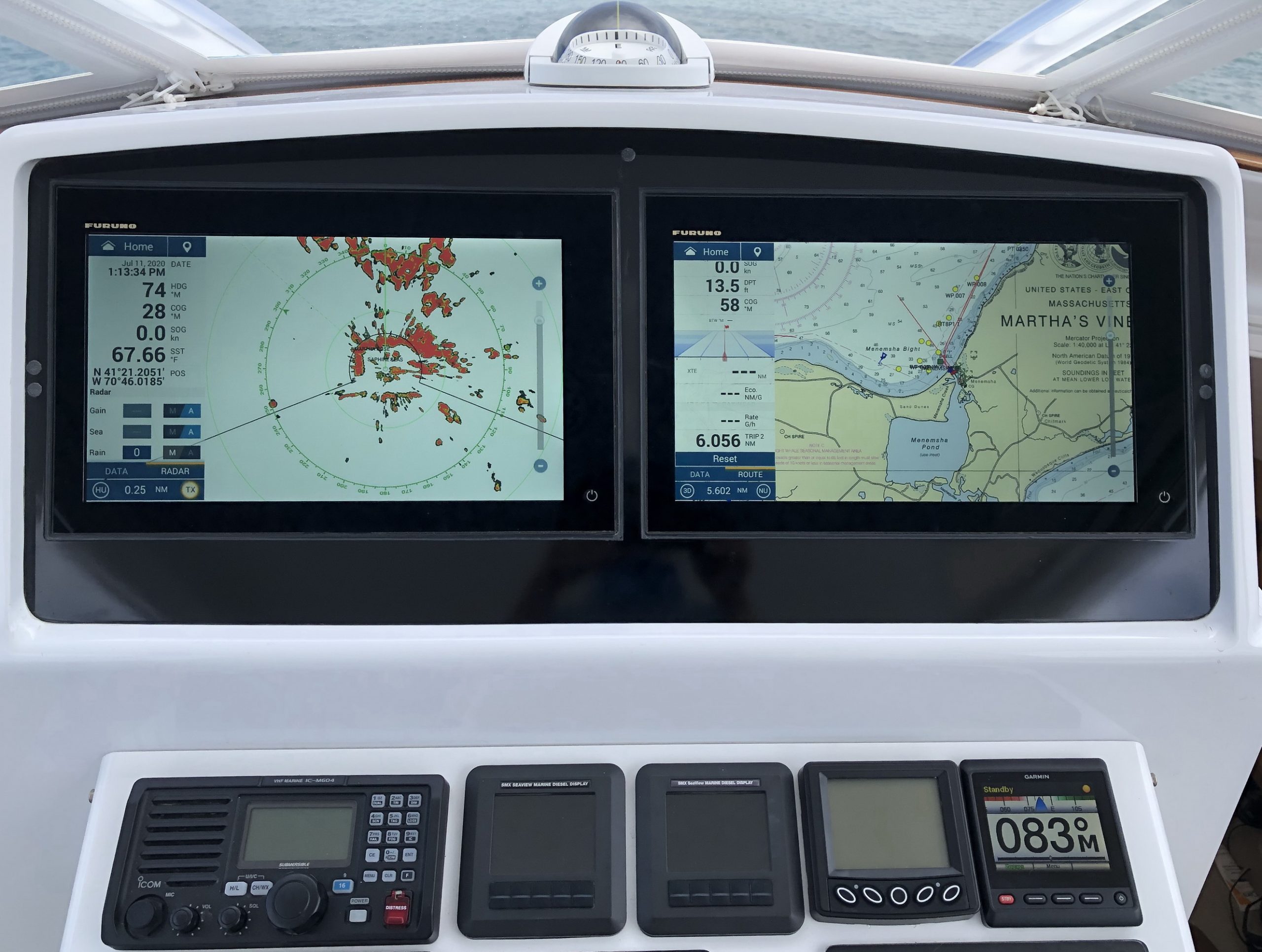







A less pleasant surprise about the Garmin 8212 is that it does NOT have WiFi built in as I had presumed. So the only way to get the nifty BlueChart Mobile integration I’ve been experiencing with the 741 ( http://goo.gl/TrJvJu ) is to get a Garmin WiFi Adapter ( http://goo.gl/TPijo0 ), which doesn’t seem nearly up to 8000 build quality, especially since I learned that it only comes rigged for 110ac power. I’ll bet another box of donuts that a real 12v waterproof Garmin WiFi network device is in the oven!
Let us know if you hear about a 12V wifi version. The 110V version is utterly ridiculous.
I don’t think a 120V version is ridiculous since most boats have inverters.
Ben: What is the intended use of the video out port? A video monitor in the Captains cabin perhaps.
IMO 120v is ridiculous
Rick, Many of the yachts that will have a large Garmin Glass Helm system will also have an elaborate A/V system so that DVI video out can provide a “navigation channel” on TV screens in the main salon, captain’s quarters, etc.
Hi def video output is a common feature on these higher end MFDs and black boxes (the Raymarine gS uses HDMI) but note that the Garmin 8515 also has a DVI-I PC video input, which means that you can have PC navigation or just regular PC programs on a high bright helm display. Garmin offered something similar on the 7215 and I believe it’s still a unique MFD capability.
And, yes, these same larger yachts will likely have an always-on inverter or may even run a generator most of the time…though they don’t generally have any AC equipment in their navigation networks. But I wish I hadn’t mentioned the WiFi adapter here and let’s please take that conversation back the original entry:
https://panbo.com/archives/2012/11/garmin_bluechart_mobile_wifi_adapter_hands-on_2.html
What I hope to see discussed here is the Volvo Penta Glass Cockpit and the general prospect of putting navigation and engine everything into one integrated system.
I love the idea of the VP integration. This is a truly glass helm …
For redundancy I would want two 8215s just like I would want two engines. Would I connect both 8215s to the “Engine CAN”?
How does a failure scenario work? When I had analog gauges one failure was only one gauge ..
One feature that is very interesting when you have two 8215s connected you can have the displays synchronized. E.g. Crusing, Fishing, etc.
Interesting subject, Pat. I don’t see any system manuals on the VP site (though I did notice how they’ve also made the GMI 20 into an engine gauge: http://goo.gl/RRSGWo
While the Garmin 8215 manuals are available online, I don’t see anything about possible network designs. But my guess is that the recommendation is to put all MFDs on the same Ethernet and N2K networks and that the engine network also goes to each MFD. Frankly, I’d be comfortable with that once it had been sea trailed a fair bit. I’d also want a good schematic of all the data and power cables for troubleshooting (possibly underway).
In a system like this there should be nothing as fragile as an electro-mechanical gauge. The data is everywhere so a single screen failure shouldn’t be an issue (unless, say, a radar is plugged into that particular screen, which is why you want the schematic). Then again, an ECU failure will probably bring down all gauges and the engine.
Whether to have a second engine (with lots of additional complexity) or just a BoatU.S. Gold Card (like I have) is a matter of endless debate.
Ben, I agree with Pat – the glass bridge concept is certainly sexy, but even glass cockpit Boeings all come with three mechanical instruments – airspeed, altimeter, and attitude, all powered (and lighted) from an emergency bus. Much like a standby compass, I think I would want at least RPM, oil pressure, and temp (perhaps combined in one standby instrument) in case all the screens go dark. Call me a pessimist…
Most engine MFG’s have their own digital readout panel coming directly from the engine. I know on my John Deer they have a digital readout of all information coming from the JD engine bus, available on both the pilothouse and the fly-bridge navigation areas.
So, that would be the back up with a full Glass Helm that is also reading the engine information via N2K.
bob
IMO built-in wifi is a waste. WiFi is best done separately via the network ports, which allows a lot more flexibility with a lower MFD cost. It does make sense to offer a 12v AP to customers, but a boat with a Garmin glass cockpit is likely to have more extensive needs than the built-in wifi offers. My 1980s 29′ does even.
Bob, in that top photo each of those three Volvo Penta Glass Helm displays is the equivalent of your John Deer engine display. Any two of them can fail, and you’ll still have engine gauges. But each engine only has one ECU and data cable, so if either of those fail, it doesn’t matter how many screens are attached.
Grant, I’m not against redundancy, not a bit. It’s just that in this case I think I’d go with the total integration concept and look for backup elsewhere. If it’s possible to get a few critical analog data points off the engine, that would be great, though I think I’d hide the gauges.
Comparisons to aviation are always a little off, however. One thing I especially like about boats is that almost every system can break and they still float.
The Volvo Glass is sure impressive. Comparison with aviation is applicable. Aircraft moved to glass cockpits many years ago. Boating is playing catch-up. Garmin is a big player there too, and their equipment has proven to be reliable.
Nothing is completely failure proof, but I don’t think redundancy is an issue to be concerned about. In the unlikely event of a catastrophic failure, e.g. all screens go blank, boaters should be able to safely continue to their destination.
As discussed here many times, an iPad with nav software (and its own battery) makes an excellent backup.
As a substitute for engine instrumentation, most engines already have a low oil pressure/over temp alarm, and it should be easy to guess at RPM using the sound of the engine and boat speed (from the iPad).
That leaves autopilot (manual steering), radar (only essential in reduced visibility) and depth sounder (which relates to the charts on the iPad).
I for one are hopeful for a “trickle down”, perhaps to smaller screens, and presumably a lower price, and compatibility with other brands of engine. Ben, do you know if Cummins is jumping on this bandwagon too?
Thanks, Rick. There’s something interesting happening regarding Navico and the Mercury VesselView electronic gauge system, and note that Mercury now includes the Zeus drive system and many of the diesel inboards that used to be marketed as Cummins MerCruiser.
Essentially, the new VesselView 7 seems to be a modified Simrad NSS7 which has both engine and nav screens. It’s not quite “glass bridge” but may be headed in that direction from the small side. I hope that more info about what it can do is revealed soon, but here’s an interesting discussion:
http://continuouswave.com/ubb/Forum6/HTML/003345.html
Maybe one day we’ll see complete Zeus drive and Merc diesel visuals on a new Simrad glass bridge system?
Hi Ben
I have heard that the Garmin 8000 series do not feature bonded LCD’s? can you check with Garmin?
If that is the case this would seem either a cost saving exercise or major shortcoming, as without a bonded screen the contrast will be poor in sunlight and the screen will likely fog up.
All the other manufactures have been using bonded LCD’s for a few years now
Nick, I suspect it’s just a matter of incomplete specs from Garmin — which seems oddly common — but it’s certainly a reasonable question. I forwarded it to my contact there but he may be out this week.
From Garmin:
“It’s definitely a good question and, yes, the 8000 series is glass bonded.
All of our marine products with displays are glass bonded except for the low-cost echo series.”